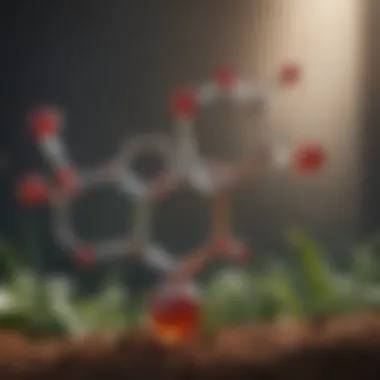Hexylresorcinol: Applications and Benefits Explored


Intro
Hexylresorcinol is an organic compound that has attracted significant attention due to its diverse applications. Most notably, its role in dermatology and food preservation stands out. This compound exhibits unique properties that make it beneficial in these fields. As a topical agent, it shows promise in various skin treatments. In terms of food safety, it helps in extending the shelf life and maintaining the quality of certain products.
Understanding the full potential of hexylresorcinol requires a deep dive into its chemical properties and mechanisms of action. This article aims to outline the relevance of this compound not only for professionals but also for enthusiasts looking to grasp its various uses. The discussion will range from scientific insights to practical applications, helping to paint a clearer picture of how hexylresorcinol fits within agricultural and horticultural contexts.
Furthermore, the implications of recent research, along with regulatory considerations regarding hexylresorcinol, need attention. This narrative seeks to highlight these aspects, particularly focusing on sustainable practices and future research directions.
Prelude to Hexylresorcinol
Hexylresorcinol is gaining recognition for its various applications, especially in dermatology and food preservation. This compound is known for its potential benefits in skin care products and as a natural preservative in the food industry. Understanding hexylresorcinol is essential for professionals in these fields as it holds promise for improving product efficacy while addressing safety concerns.
Definition and Chemical Structure
Hexylresorcinol, with the chemical formula C128O2, is a bisphenolic compound derived from resorcinol. It features a six-carbon chain attached to a resorcinol moiety. The unique structure confers particular properties that make it suitable for various applications. This molecule exhibits antioxidant activities and has shown potential for skin lightening, positioning it as a desirable ingredient in cosmetic formulations. Understanding its chemical structure helps experts appreciate how hexylresorcinol interacts at the molecular level, leading to its diverse functional benefits.
Historical Context
The history of hexylresorcinol can be traced back to its discovery in the early 20th century. Initially used in pharmaceutical applications due to its antimicrobial properties, its potential in dermatological treatments began to garner attention. The shift towards natural and organic compounds in consumer products has revived interest in hexylresorcinol. Recent studies have expanded its applications into food preservation, highlighting its role in enhancing food safety. Moreover, the regulatory landscape is evolving, which impacts how this compound is perceived in both health and agricultural sectors. The trajectory of hexylresorcinol illustrates the growing intersection between science and consumer preferences in sustainable practices.
Chemical Properties
Understanding the chemical properties of hexylresorcinol is crucial for comprehending its multifaceted roles in both dermatology and food preservation. These properties define how hexylresorcinol interacts with various substances, influences its effectiveness, and determines its safety profile. For agricultural farmers and enthusiasts, knowing these chemical characteristics can guide decisions about using this compound in sustainable practices.
Molecular Characteristics
Hexylresorcinol is a dihydroxy phenolic compound, possessing a chemical formula of C_12H_16O_2. This structure comprises a phenolic ring with two hydroxyl groups at the 4- and 5-position. The presence of the alkyl chain enhances its lipophilicity, allowing it to permeate biological membranes effectively. This lipophilic nature contributes to its usefulness in skin applications, where deeper penetration can lead to improved outcomes in skin lightening and antimicrobial activity.
This compound exhibits a moderate molecular weight, which can facilitate its absorption by the skin. The molecular characteristics are significant, as they dictate the physicochemical behaviors that impact how hexylresorcinol can be used in various applications. By knowing these features, scientists and practitioners can tailor formulations for optimized results.
Solubility and Stability
Hexylresorcinol is slightly soluble in water but significantly more soluble in organic solvents such as ethanol and acetone. This solubility pattern is vital for various applications, particularly in formulations intended for topical use. When products are designed to be used on the skin, the solvent choice can influence the stability and delivery efficiency of hexylresorcinol.
In terms of stability, hexylresorcinol is generally stable under normal storage conditions, though it may degrade when exposed to high levels of light or extreme heat over time. This degradation risk highlights the need for careful formulation and packaging practices to ensure prolonged efficacy in treatments. Being aware of solubility and stability is essential for ensuring that the compound maintains its effectiveness throughout its intended use.
Photostability
Photostability refers to a compound's ability to withstand degradation when exposed to light. For hexylresorcinol, this property is particularly important in dermatological applications, as products are often applied in environments with significant exposure to sunlight. Studies show that hexylresorcinol exhibits reasonable photostability under UV light, making it suitable for use in formulations intended for daytime application.
However, while its photostability is acceptable, there is still the possibility of some degradation over extended periods. Awareness of this limitation can help formulators make informed choices about preservative systems and packaging designs, allowing them to maximize the compound's effectiveness. Farmers and producers should remain vigilant about these factors when integrating hexylresorcinol in their products.
"Understanding the chemical properties of hexylresorcinol is crucial for its effective application across various industries."


By examining the chemical properties, especially the molecular characteristics, solubility and stability, and photostability, manufacturers can create more effective products. Knowledge of these aspects allows for better formulation strategies and ultimately enhances the compound's utility in both dermatology and food preservation contexts.
Role in Dermatology
Hexylresorcinol has gained prominence in dermatology due to its multifaceted applications and notable benefits. As an organic compound, it is particularly valued for its ability to address several skin issues, including hyperpigmentation, infections, and wounds. Its incorporation into topical formulations is supported by scientific evidence and clinical experiences, making it a sought-after ingredient for both consumers and healthcare professionals.
Mechanism of Action
The mechanism of action of hexylresorcinol primarily revolves around its capacity to inhibit tyrosinase activity in melanocytes. By interfering with this enzyme, hexylresorcinol reduces melanin production, which is beneficial for conditions such as melasma and age spots. Furthermore, it possesses antimicrobial properties that support skin barrier function and promote healing. This dual action makes it a powerful tool in dermatological treatments.
Clinical Applications
Hexylresorcinol plays a significant role in various clinical applications:
Skin Lightening
Hexylresorcinol is commonly used for skin lightening. Its ability to lessen hyperpigmentation is a key feature. It acts quickly and effectively, thus making it a popular choice in cosmetic dermatology. Users appreciate its efficacy compared to other agents like hydroquinone, which can have adverse effects. However, care must be taken with long-term use, as it may lead to skin irritation in some individuals.
Antimicrobial Properties
The antimicrobial properties of hexylresorcinol are crucial in dermatology. It can effectively combat a range of pathogens, which contributes to its usage in formulations targeting acne and other skin infections. This characteristic enhances skin health by reducing inflammation and preventing the proliferation of harmful microbes. Its advantage lies in being less irritating than traditional antibiotics, but some caution is necessary regarding resistance development with prolonged use.
Wound Healing
Hexylresorcinol has demonstrated promise in wound healing applications. It facilitates the healing process by promoting cell proliferation and reducing inflammation at the wound site. This characteristic positions it as a beneficial option for topically managing minor cuts and abrasions. The unique advantage of hexylresorcinol here is its non-toxic nature, allowing for broader applications. However, more research is needed to understand its full potential in chronic wound management.
Efficacy Studies
Evaluating the efficacy of hexylresorcinol has been a focus of several studies. Research generally supports its use in various dermatological treatments, reinforcing its applications in skin lightening, antimicrobial effects, and promotion of wound healing. Current studies suggest that hexylresorcinol is effective, but additional long-term studies are necessary to determine its resilience and safety in prolonged usage.
Applications in Food Preservation
The role of hexylresorcinol in food preservation is increasingly relevant as concerns about food safety and quality become more pronounced. As a natural compound, hexylresorcinol provides a viable alternative to synthetic preservatives. This shift aligns with consumer preferences for cleaner labels and more natural ingredients. The focus on applications in food preservation highlights several important aspects, including antioxidant properties, regulatory considerations, and the changing market landscape.
Antioxidant Properties
Hexylresorcinol possesses noteworthy antioxidant properties that are critical in food preservation. Antioxidants play a vital role in preventing the oxidation of food, which can lead to rancidity and loss of nutritional quality. By inhibiting oxidative processes, hexylresorcinol can extend the shelf life of various food products.
Some benefits of these properties include:
- Extended Freshness: By slowing down spoilage, food products remain fresh longer, which can reduce waste.
- Preservation of Nutrients: Antioxidants like hexylresorcinol help retain essential vitamins and minerals in food.
- Improved Flavor and Color: By preventing oxidative damage, the sensory qualities of food are maintained, enhancing overall appeal.
These properties make hexylresorcinol particularly valuable for the food industry, where quality and sustainability are paramount.
Food Safety Regulations


Food safety is another major consideration when discussing hexylresorcinol. Various regulations govern the use of preservatives in food products. Hexylresorcinol has been evaluated by multiple health authorities to ensure its safety and efficacy.
Regulatory standards often include:
- FDA Approval: In the United States, the Food and Drug Administration assesses substances for their safe use in food applications.
- EFSA Evaluation: The European Food Safety Authority also carries out assessments to govern the use of food additives.
- Compliance with International Standards: Organizations like the Codex Alimentarius set international guidelines for food safety, which hexylresorcinol must meet.
As regulations evolve, the acceptance and application of hexylresorcinol may expand, possibly leading to wider use in food preservation strategies.
Market Trends
Market trends in food preservation reflect a shift towards incorporating more natural and less synthetic additives. The demand for hexylresorcinol is rising as consumers increasingly prefer products that are perceived as healthier and safer.
Key trends include:
- Organic and Natural Products: There is a growing market for organic foods that utilize natural compounds for preservation, making hexylresorcinol a suitable option.
- Transparency in Labeling: Consumers are seeking clarity about what is in their food. Hexylresorcinol fits this criterion as it is a naturally occurring substance, appealing to health-conscious buyers.
- Innovation in Food Technology: Research into novel applications of hexylresorcinol in food systems is underway, potentially leading to innovative products that use this compound effectively.
Sustainability and Environmental Impact
Sustainability is crucial in today's discourse surrounding agricultural and industrial practices. The impact of synthetic preservatives on the environment has prompted a search for safer and more sustainable alternatives. Hexylresorcinol stands out in this respect, as its natural properties align well with contemporary sustainability goals.
Reduction of Synthetic Preservatives
One of the key benefits of using hexylresorcinol is its potential to replace synthetic preservatives in various applications. Synthetic preservatives often raise health concerns and environmental issues. In contrast, hexylresorcinol, being a naturally occurring compound, offers a more favorable profile. Its antioxidant properties not only enhance the shelf-life of products but also minimize the risk of toxic byproducts.
- Natural Efficacy: Hexylresorcinol has been shown to be effective against a range of microorganisms. This efficacy can reduce reliance on harsher chemical alternatives that often disturb ecological balances.
- Lower Risk: Understanding the safety profile of hexylresorcinol helps mitigate concerns over residues in food and skin care products. Its use could lead to safer products without compromising efficacy.
- Degradation: This compound tends to decompose into less harmful substances, which lessens its environmental footprint compared to some synthetic options.
Role in Organic Agriculture
Organic agriculture demands methods that respect environmental integrity, and hexylresorcinol aligns with these principles. Its use in organic farming can lead to healthier ecosystems and better soil quality. As an organic compound, hexylresorcinol does not interfere with the natural biomes necessary for sustainable agriculture.
- Pest Control: The compound has potential applications in organic pest management solutions. It provides a biodegradable alternative that can help keep crops healthy without adverse effects on the surrounding wildlife.
- Soil Health: Application of hexylresorcinol can also contribute to promoting soil health. By minimizing harmful chemical interactions, it helps maintain the biodiversity within the soil ecosystem.
- Market Demand: As consumer preference shifts towards organic and sustainably sourced products, the role of hexylresorcinol may enhance marketability and provide farmers with an edge.
Hexylresorcinol represents a crossroads between efficacy and environmental responsibility. Its characteristics support the move towards sustainable practices without sacrificing quality.
"Transitioning to natural alternatives like hexylresorcinol is not merely a trend; it is an essential step for future sustainability in agriculture and therapy."
Health and Safety Considerations
Exploring the aspects of health and safety regarding hexylresorcinol is crucial. It ensures that this organic compound can be safely utilized in various applications, particularly in dermatology and food preservation. Understanding the toxicological profile and compliance with regulations is vital for both manufacturers and consumers. Proper knowledge of these factors plays a significant role in ensuring its effective use without adverse effects on health, which is increasingly important in today’s health-conscious society.
Toxicology Studies
Toxicology studies are essential for determining the safety of hexylresorcinol. They assess the potential hazards that may arise from exposure to this compound. Research shows that hexylresorcinol generally has a favorable safety profile.
Key points from toxicology studies include:


- Low toxicity levels: Most studies indicate that when used topically, hexylresorcinol does not produce significant toxic effects. This makes it suitable for dermatological applications.
- Skin irritancy: Some experimental studies have evaluated skin irritancy. Results showed minimal risk for irritation, provided the correct concentrations are used.
- Long-term effects: Limited data are available on long-term exposure. More comprehensive studies are necessary to fully understand any potential cumulative effects on human health.
These findings suggest that hexylresorcinol can be considered safe for its intended uses, but continued research is needed to address long-term implications.
Regulatory Standards
Regulatory standards serve as guidelines to ensure that hexylresorcinol is used safely and effectively. Different countries have varying regulations regarding the allowable limits and application methods of hexylresorcinol.
- United States: The FDA has approved hexylresorcinol for use in specific cosmetic products. Compliance with the Food, Drug, and Cosmetic Act ensures it meets safety standards for human use.
- European Union: The European Commission assesses hexylresorcinol under the REACH regulation. This helps to ensure that it poses no harm to human health and the environment while in use.
- Labeling requirements: Manufacturers must adhere to proper labeling, specifying concentration levels and intended uses. This ensures transparency and consumer awareness.
In summary, health and safety considerations regarding hexylresorcinol are paramount. They encompass toxicology studies that suggest a low risk of toxicity and regulatory frameworks that provide guidelines for safe use. Further research and adherence to standards will continue to support the beneficial applications of hexylresorcinol.
Future Research Directions
Understanding the future research directions of hexylresorcinol is critical for both its applications in dermatology and food preservation. As new discoveries emerge, there is potential for expanded uses of this compound and improved formulations that address emerging challenges.
Emerging Trends in Applications
Recently, there has been an increase in attention towards the multifunctionality of hexylresorcinol. Research may focus on its synergistic effects when combined with other compounds, such as antioxidants and peptides, to enhance skin benefits. Additionally, exploring its efficacy not only in traditional dermatological uses but also in innovative sectors like cosmetic formulations may pave the way for new products. In food systems, the trend shifts towards natural preservatives. Hexylresorcinol's role in addressing consumer demands for clean labels could be highlighted by further studies.
Long-term Efficacy Studies
Long-term efficacy studies are vital for establishing the safety and effectiveness of hexylresorcinol in both dermatological products and food preservation. Such studies can provide evidence of sustained efficacy over time, which is especially important in dermatology where long-term effects and skin reactions must be quantified. Rigorous clinical trials could give insights into its prolonged safety profile, thus reassuring consumers and regulating bodies. It helps in building a solid scientific basis for product dosages and application guidelines.
Potential for Novel Formulations
The potential for novel formulations of hexylresorcinol remains vast. Research could explore novel delivery systems, such as nano-encapsulation, which may improve its stability and penetration in the skin. Furthermore, combining it with biodegradable materials could enhance its application in organic agricultural practices. Innovative formulations may broaden the scope for specific consumer needs, such as sensitive skin products or those tailored to specific food preservation goals. Future studies that investigate these approaches will be crucial for pushing the boundaries of hexylresorcinol's applications.
"Continued research on hexylresorcinol will help inform its applications and pave the way for innovative products that resonate with both consumer needs and regulatory standards."
In summary, future research directions for hexylresorcinol offer rich avenues for exploration. Emerging trends highlight the need for innovative applications, while the importance of long-term efficacy studies cannot be overstated. Potential formulations could be the key to unlocking new market opportunities and enhancing product performance across sectors.
Culmination
The conclusion of an article serves to synthesize key insights and underscore the significance of the discussed material. In the context of hexylresorcinol, it is paramount to recognize how this compound functions as a multifaceted agent within both dermatological and food preservation frameworks.
Summary of Key Points
Hexylresorcinol possesses notable properties that contribute to its utility in various sectors:
- Chemical Characteristics: The compound features distinct molecular properties that aid its efficacy in applications ranging from skincare to food safety.
- Clinical Uses: Its role in dermatology includes skin lightening, antimicrobial effects, and wound healing attributes.
- Food Preservation: Hexylresorcinol's antioxidant properties support food safety and help extend shelf life, aligning with market trends focused on natural preservatives.
- Environmental Considerations: This compound supports sustainable practices by reducing dependence on synthetic additives and enhancing organic agriculture initiatives.
- Future Directions: Research suggests potential for novel formulations and long-term studies to further explore hexylresorcinol's efficacy and applications.
Final Remarks
In sum, hexylresorcinol represents a compelling subject for ongoing research and professional exploration. Its diverse applications indicate not just versatility but also promise in enhancing health and safety standards.
"The understanding and implementation of hexylresorcinol in various contexts could very well represent a significant advancement in both dermatology and food science."
For agricultural farmers and enthusiasts, the implications of hexylresorcinol are tangible. Its adoption could foster sustainable practices and improve product quality, reinforcing the importance of ongoing discussion and investigation into its benefits.
Conclusively, hexylresorcinol's role in modern science and agriculture is vital. As research unfolds, it will be critical to remain informed on its evolving applications and to ensure regulatory compliance to maximize its positive impact.







